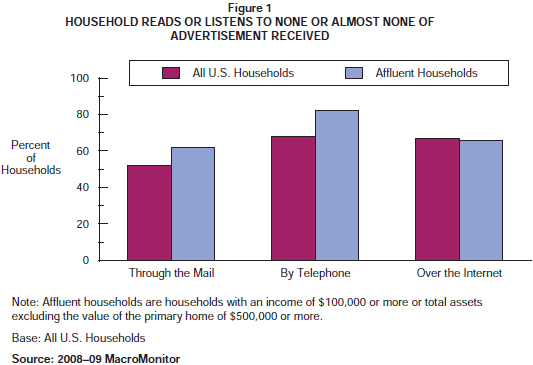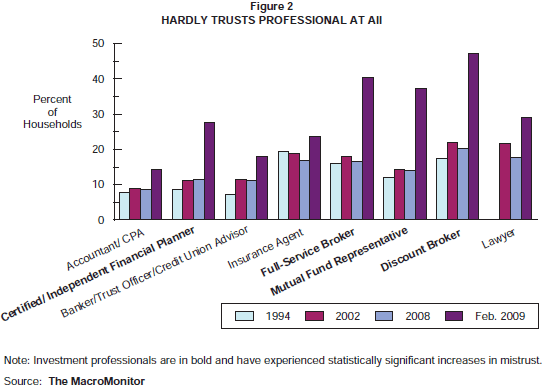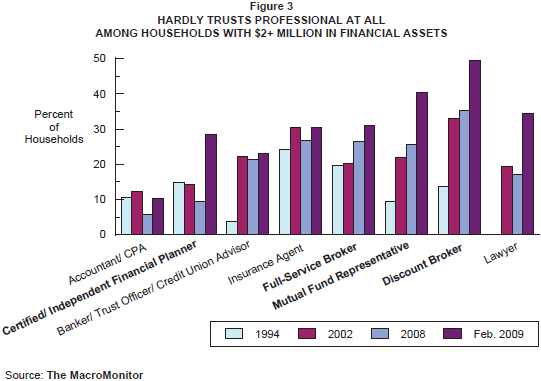MacroMonitor Market Trends June 2010
MacroMonitor Market Trends is a newsletter from the Consumer Financial Decisions group that highlights topical news and trends of interest to you and your colleagues. If you would like more information about the items in the newsletter or would like to discuss other ways that we can assist you in your research and marketing efforts, please contact us.
In this issue:
Affluent Households Are Not Paying Attention
In a typical month, Affluent households receive more than 25 financial advertisements through direct means (through mail, telephone, or the Internet); households overall receive 22 ads per month. MacroMonitor data, however, indicate that these ads may go unnoticed—especially among Affluent households. As Figure 1 portrays, more than 60% of Affluent households report that they read none or almost none of the financial advertisements they receive in the mail, and more than 80% listen to none or almost none of the financial advertisements they receive by telephone. These incidences are significantly higher than those for households overall—19% and 21% higher, respectively. Affluent households pay attention to Internet ads at about the same rate as do households overall: 67% of all U.S. households and 66% of Affluent households pay no attention to Internet advertisements. Attitudinal and product-ownership data confirm Affluent households' receptivity toward the Internet: 63% of Affluent households—in comparison with 45% of households overall—agree the Internet is a good tool for finding financial information, and 43% of Affluent households obtained a financial product or service from the Internet in the past two years, in comparison with just 31% of all U.S. households.

Given their preference for using the Internet, financial providers attempting to reach Affluent households may need to adjust their marketing strategy by directing more resources to targeted online advertising. In 2008, Affluent households received 20% more financial advertisements via the mail than did the average U.S. household (19 ads in a typical month in comparison with 16, respectively) and received 17% fewer financial ads over the Internet (23 ads in a typical month, in comparison with 28, respectively). Thus, financial institutions may do well to reduce the number of mail and telephone ads they direct to Affluent households and increase their online advertising initiatives in order to maintain and grow their Affluent customer base.
The Crisis in Trust Affects Everyone
From Main Street to Wall Street, anger is everywhere. This anger translates into a huge increase in the number of households that have little trust in their institutions and their financial intermediaries. From before the huge runup of the Bull Market during the second half of the 1990s through the ups and downs of the 2000s (perhaps best called the "Uh-ohs"!) this mistrust has seen a significant increase, especially since 2008.

Among the general population, this huge increase in mistrust is particularly evident among investment professionals: The level of mistrust among certified financial planners, independent financial planners, full-service brokers, mutual fund representatives, and discount brokers more than doubled between the summer of 2008 and February 2009. (Respondents had the choice of ranking their trust in each type of financial professional using a simple three-point scale: a great deal of trust, some trust, hardly any trust at all, and don't know.) However, some people might assert that many people have less experience with investment intermediaries than, say, with bankers or insurance agents, so they may be (over?) reacting to media focus. The more experienced and wealthier households are more sophisticated and should have a more realistic sense of the role of investment advisors; they may not be as distrustful.

As of when we last asked the question in February 2009, at the depth of the market decline, the same proportions of households with $2 million or more in financial assets (includes 401(k) balances) as in the general population report the same high levels of mistrust. The only case in which a significant difference exists is that people with $2 million or more in financial assets are less likely to mistrust their full-service brokers.
Table 1Household Has Hardly Any Trust in Financial Professional (February 2009) |
|||
|---|---|---|---|
| Professional | All HHs (Percent) | HHs with $2MM+ Financial Assets (Percent) | Difference (Percent) |
Note: Bold indicates that the difference is statistically significant. Source: 2008–09 MacroMonitor Recontact Study |
|||
| Accountant/CPA | 14 | 10 | –4 |
| Certified/Independent Financial Planner | 28 | 28 | 1 |
| Banker, Trust Officer, Credit Union | 18 | 23 | 5 |
| Insurance Agent (Company or Independent) | 24 | 31 | 7 |
| Full-Service Broker | 41 | 31 | –10 |
| Mutual Fund Representative | 37 | 40 | 3 |
| Discount Broker | 47 | 50 | 2 |
| Attorney/Lawyer | 29 | 35 | 6 |
Given their experience during the Uh-ohs, wealthy households have found their trust in most financial intermediaries already eroding. Unlike the general population, the proportion of the wealthy who report that they mistrust bankers, insurance agents, full-service brokers, mutual fund representatives, and discount brokers had already crept up from the levels in 1994 to higher levels in 2002 and 2008. But the reaction to the recession and huge market declines that started in September 2008 shows large increases in mistrust of financial professionals among households with $2+ million in financial assets. It is hard to imagine how—with their increased experience and sophistication—these wealthy households will snap back to trusting their financial advisors, once the market returns. The key question is, once the anger fades, How will these wealthy households act in this new, post–Goldman Sachs environment?
CFD Hosts Financial Needs in the New Normal Mini-Presentation
The financial-services industry is experiencing some of the most gut-wrenching changes of the past three decades. To provide timely insights, we have redesigned the 2010–11 MacroMonitor to measure how these changes have affected consumers' financial needs, behaviors, and attitudes. On 25 May 2010, CFD hosted the first in a series of half-hour mini-presentations—Financial Needs in the New Normal: From Measurement to Insight—to discuss how we have improved the 2010–11 MacroMonitor to understand consumers' financial needs better by answering questions such as:
- What types of financial needs exist?
- How important are those needs?
- How well are companies fulfilling customer needs with current products and services?
The new 2010–11 MacroMonitor Needs Analysis will provide important connective tissue to product and service measures as well as insight into what customers with a high level of self-reported need in a category are actually doing and what they are missing. Financial-service providers will be able to leverage this understanding of household financial needs—at both general and specific levels—to manage their product portfolios and customize offers. To learn more about financial needs in the New Normal, e-mail us at to obtain a copy of our mini-presentation.